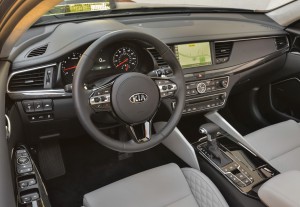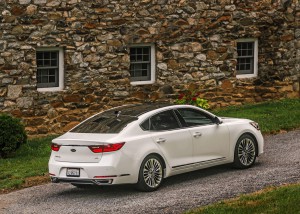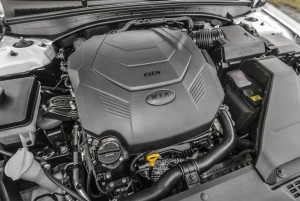While Kia has made its mark building small cars and clever compact crossover vehicles, the South Korean automaker’s ambitions have grown right along with its sales and reputation.
With the introduction of the new 2017 Kia Cadenza, the company, which was the first non-luxury brand in 27 years to come out on top of J.D. Power’s closely watched IQS survey, takes dead aim a shrinking – but still important – segment dominated by traditional nameplates such as Toyota Avalon, Buick LaCrosse, Chevrolet Impala and Chrysler 300.
It replaces a car that was added to the Kia line-up three years ago almost as an afterthought with a new model that is larger, lighter, handles better and more powerful than the car it will replace this fall.
Moreover, the Cadenza is everything motorists have come to expect in a large, quasi-luxury sedan. It’s roomy and quiet, comfortable on the inside and disarmingly easy to drive on more demanding roads and in heavier traffic.
The front-wheel-drive Cadenza performed well during our test drive, mastering the twists and turns in hilly roads in and around the Shenandoah Valley. Moreover, with its long, 112.4-inch wheelbase, the Cadenza is large enough to provide the feeling of solidity that have always made big four-door sedans on American highways down through the years.
The power steering responds quickly with minimal force, while providing feedback to alert the driver to challenges around the car while the brakes on the 19-inch wheels were perfectly adequate.
(Buyers take a breather as August auto sales slump. For more, Click Here.)
Kia, like its South Korean partner Hyundai, has also worked hard in past few years at improving the quality and the workings of the suspension underneath the car and it shows on the Cadenza. The result is a suspension system that reinforces the car’s overall sense of stability. It’s not stiff or sporty, but it doesn’t seem too soft and holds the road on tight curves.
Kia’s engineers also have managed to reduce the overall weight of the Cadenza by 36 pounds. It’s not much but every little bit helps make the car more nimble. The co-efficient of drag of the Cadenza’s handsome exterior design, which looks confident and poised both while standing at the curb and while car is in motion, has been reduced by a fraction to .28 from .29.
The driving experience is supported by a Kia’s 3.3-liter V6 engine, which has been revamped to deliver better fuel economy, which is 20 miles per gallon in the city and 28 mpg on the highway and 23 mpg combined — a slight improvement over the 2016 Cadenza.
The new Cadenza equipped with a V6 engine also produces 290 horsepower and 253 lb-ft. of torque and the power flows to the through first front-wheel-based eight-speed automatic transmission. The new transmission is very efficient shifting up and down easily as the car is maneuvered up and down hills and around curves with smooth, quiet and seemingly efficient shifts.
The new the eight-speed transmission, which was designed by Kia, is also lighter than the unit in the outgoing model and offers drivers three different operating modes. The power train also offer three-different driving, normal, eco and sport.

With easy-to-read gauges and conveniently placed controls for the infotainment and climate control functions, the new Cadenza is an ideal road car.
(Click Here for details about how to find a good deals on outgoing models.)
Kia has taken great pride in its exterior during it has moved up through the ranks of the world’s carmakers on number of different measures.
With the Cadenza shows the head of Kia’s design office, Peter Schreyer, describes as “the simplicity of the straight line,” with a contour line the entire length of the car to help create an arresting silhouette. The profile is matched up with lighting in the front and rear that is designed to make an impression both at and during the day.
The Cadenza’s front fascia has been reworked to include a new hexagonal grille that melds with the headlights in a distinct concave grille, which curves into the car’s mass and looks quite impressive up close and in all kinds of light.
On the inside, Kia has departed from years of emphasis on command seating and lowered the driver’s seat has been for a sportier and more stable feeling, making the car more fun to drive. The interior is redesigned with better materials with a soft touch than in the earlier version of the car and with higher levels of craftsmanship.
Visibility from the driver’s seat is very good and the controls, which are augmented on the steering wheel, are easy to reach and to use. The touch screen in the center stack responds quickly to the human touch
The result is a cabin space that all at once exudes a luxurious feel and is practical and technically up to date. The technical features include on the Limited, which is the top trim level and is expected to go for around $44,000 includes a heads-up display with a turn by turn navigation feature and a surround view monitor to keep track of everything around and the 8-inch tough screen with navigation.
In addition, all three version, Premium, Technology and Limited, are equipped with a wireless charger for a smart phone Kia’s “UVO” connectivity system with Bluetooth and that now also features Android Auto and Apple Car play.
The Cadenza is also equipped with a full array of safety features, including a complete array of air bags, anti-lock brakes and stability control. The Technology and Limited versions of the Cadenza also comes with a full array of driver assistance features including rear-cross traffic alert, lane departure warning, blind-spot detection and forward collision alert.
(For more about Kia pinning it’s growth plans on the new Cadenza, Click Here.)
Overall, the Cadenza is a very good car with impressive styling. But while it very well equipped with latest technology and comfort and convenience feature, its fuel-economy isn’t terribly impressive and the driving dynamics don’t separate it from the competition in the segment.



